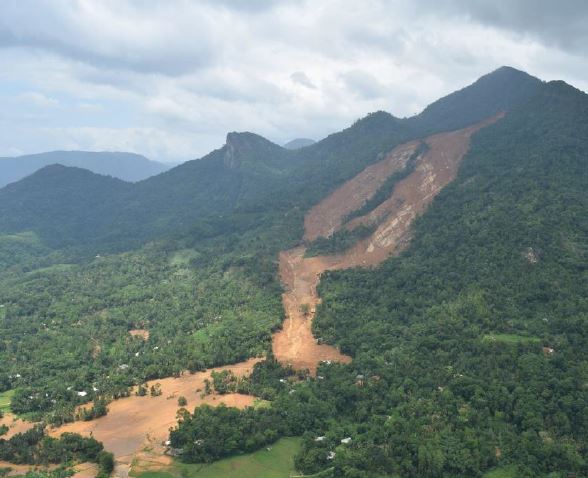19 July 2016
The Aranayake landslide disaster in Sri Lanka – a JICA report
Posted by Dave Petley
The Aranayake landslide disaster in Sri Lanka
JICA has now posted a report online (NB it’s a PDF) providing the initial results of an investigation of the May 2016 Aranayake landslide disaster in Sri Lanka, which killed 127 people.
This is a complex landslide – the image below from the report provides the best overview of the whole of the landslide, from the small failure at the crown to the debris flow at the toe:

The Aranayake landslide in Sri Lanka, from the JICA report
.
This this image shows the complex translational component of the landslide. The report points out the unusual width of the landslide, which was not evident in most of the images at the time:

The main part of the Aranayake landslide in Sri Lanka, via JICA
.
I think there are two really revealing aspects to this report. First, it provides a detailed aerial image of the very crown of the landslide:

The crown of the Aranayake landslide, via JICA
.
Whilst it might on first inspection be thought that this small failure induced the overall collapse, this strange feature in the very crown of the landslide may well be a secondary failure, judging by the debris on the slope below. However, I still believe that the landslide was initiated by a failure in the crown area (but possibly over a larger area than shown above). It is interesting that the primary forest appears to have been removed in the areas on the flanks of the landslide shown in this image. This might provide an explanation for why this first failure developed.
Second, the report provides details of the settlements that were destroyed by the landslide:

Settlement locations on the Aranayake landslide, via JICA
.
An interesting question is whether this specific landslide could have been anticipated. This is the outline of the landslide superimposed onto a slope angle map:

The outline of the Aranayake landslide superimposed onto a slope map, via JICA
.
It is probably fair to say that the specifics of this landslide could not have been identified in advance. This type of very complex, cascading failure is always going to be exceptionally hard to anticipate. However, that this type of landslide will occur in general in exceptionally heavy rainfall in the mountains of Sri Lanka can be anticipated. The houses located in the lower channel of the landslide, which is clearly identifiable in the image above, were probably at an unacceptably high level of risk from the perspective of landslide hazards.
Acknowledgement
Thanks to Kenichi Handa of JICA for highlighting this report to me, and for the most interesting discussion.


 Dave Petley is the Vice-Chancellor of the University of Hull in the United Kingdom. His blog provides commentary and analysis of landslide events occurring worldwide, including the landslides themselves, latest research, and conferences and meetings.
Dave Petley is the Vice-Chancellor of the University of Hull in the United Kingdom. His blog provides commentary and analysis of landslide events occurring worldwide, including the landslides themselves, latest research, and conferences and meetings.
Thank you for your valuable work. Please contact me to discuss how Drone Technology can be used to anticipate landslides and on rescue operations
Thanks again